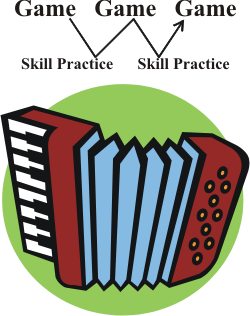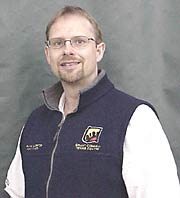|
TennisOne Lessons Progressive Tennis: Starting players at ˝ Court Wayne Elderton In this series of articles, we have explored the reasons why the Progressive Tennis system of scale appropriate racquets, courts, balls, and competition, gives tremendous advantages for developing the technical and tactical foundations of tennis. Now we get to move into the details of how to do it! We will start with the ½ Court level (5-7 year olds).
Even though this article is in reference to ½ Court players, the same philosophy and methodology would be used with starter ¾ Court players. In regards to methodology, it is important for a coach to decide the methodology they intend to use. Why is this significant? Because, every path a coach takes has different consequences on the learner. Most coaches realize that the game has changed. This has lead to the "stuff" they coach being different (e.g. modern techniques). What is less known is the process of coaching has also evolved as the ways people learn and process information is researched. Traditional tennis instruction started with the philosophy of "teaching the basic strokes." The first lesson would start with an idealized model of the forehand that the coach demonstrated and everyone copied. The goal of the lesson was to conform students to the model of the stroke. New information, coming from the best coaching practices used in the top tennis nations, point to another method that is far more effective (in contrast to the one described above). The Game-based Approach (GBA) comes at learning tennis from another angle. It is not about strokes, but rather connecting the tactics and techniques of play. The philosophy moves from teaching the basic strokes to "‘play the game," and helping players learn the tactics and techniques to play more successfully. We will outline the basic steps beginning players would perform to learn tennis in a GBA and contrast that with a typical traditional lesson process. Coordination is the Foundation
The basic rule for long-term development (that is the best perspective to have when developing a 5-7 year old player) is, “develop an athlete first, a tennis player second.” A solid foundation of coordination skills that include running, throwing, catching, jumping, etc. is invaluable for future success in tennis. There is plenty of literature and videos on this kind of development. It should be included at the beginning of every child’s training session. However, just to speed things up, I am going to focus on tactical/technical development. The First Step In traditional coaching, the first step is to learn the forehand. In a GBA, tactics come first, and the first tactic a player needs for success in tennis is to keep the ball in play consistently. Tennis is a game of errors. Traditional coaches would typically use basket feeding to introduce the forehand technique. In a GBA, players are most often in ‘live ball’ situations (exchanging with each other). A traditional coach might modify the feeding (feed by hand) to simplify the skill if the students were having trouble (the students would be on the baseline). As a further simplification, some coaches may place them on the service line (commonly however, they would still aim for sending their strokes to the opposite baseline). The main points of emphasis would be the stroke techniques involved in performing the whole swing shape. The techniques would be "chained" together in sequence (preparation, contact, then follow-through). By contrast in a GBA, the game would be scaled down to whatever level is required for the players to experience success. To develop the tactic of consistency, the first step in a GBA would be to learn to “Rally.” Skill Blocks for RallyingTo develop solid rally skills, the elements that improve play come in 3 main "Skill Blocks." The coach chooses which skills from each block are required to improve the player. Block #1: Tracking, Catching, and Throwing Skills: For improving perception, reception, and understanding how to feed the ball to a partner for future practice (If players learn to send the ball to each other, they dramatically increase the potential repetition for practice) Block #2: Racquet Skills: For improving centering and creating a good impact point in relation to the body as well as having a stable racquet through the hitting zone and controlling the ball. Block #3: Body Coordination Skills: For improving the linkage of using the legs, body, and arm together (Players typically start with an "arm-only" style of play).
An astute coach or parent may say, “Hold on, isn’t there a missing block? Shouldn’t footwork be a block as well?” The answer is, footwork isn’t a separate skill development block. It is so important that it is in every block. All skills progress from static (not much movement) to dynamic (done with movement). Self Rally to Develop Technique
The secret to rally development is to understand that a rally is an equation. Ball received = ball sent. It is a neutral exchange. There is a reception and a projection that are both equally important. The glitch that occurs in traditional coaching is the inequality of the reception compared to the projection. Typically, the coach sends an easy to receive ball (sometimes being so accurate with their feed that they actually hit the players racquet). The player, on the other hand, is encouraged to whack the ball anywhere into the court. The challenge is this inequality transfers poorly when the player goes into the "real world" and tries to rally with partners. In reality, the starter players should develop their reception skills more than their projection to truly gain consistency. To ease into learning how to rally, players need to exchange the ball in the lowest pressure and simplest situation available. This would be for a player to rally with themselves (Self-rally). The task of self-rallying is used to help players learn how to organize themselves around the most important moment of any tennis shot, the Impact Point. Self-rally allows for easier development of:
The "Accordion" Method of Skill BuildingThe Skill blocks build on each other however, coaches should avoid doing the first block completely then the next, then the next, etc. The goal is to have players engage in play quickly. Coaches should flip-flop back and forth between having players play the game (serve, rally, score or simply exchanging at the initial levels), improving skills by applying Skill Block activities, then return to playing. This going in and out from play, to practice, to play, is what I call the "Accordion" method. For example, in a training session for groundstrokes, players would be paired for rallying together. The coach would see the quality of their technique during their exchanges. If they had difficulties with a stable, laid-back wrist (Racquet Skills Block #2), the coach would then gather the players for an exercise to improve that aspect of their technique (e.g. rolling the ball along the ground). After the exercise, they would return to exchanging and incorporate the improved technique.
Using this method speeds a players’ progress by maintaining the fun of play. It also speeds learning by "Chunking" skills into bit-sized pieces that are easily assimilated. Chunking is a way of sequencing skills in harmony with the way children learn. If a skill is learned, practiced a little, and then left (to do other things), the skill is like a seed that germinates in a child’s body. This is more effective than spending a long period on one skill. Conclusion We have explored the first steps and practice activities required to get 5-7 year olds on a firm tennis foundation. Subsequent articles will add the next steps in the progression. This process is quite different from the traditional ball feeding method coaches have commonly employed however, it is much more effective at developing rally fundamentals. Just as a final note. This method has also been used with great success with adult starter players. Your comments are welcome. Let us know what you think about Wayne Elderton's article by emailing us here at TennisOne.
|



 Wayne Elderton
Wayne Elderton